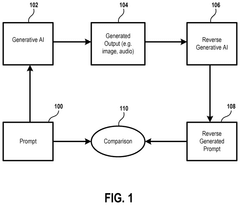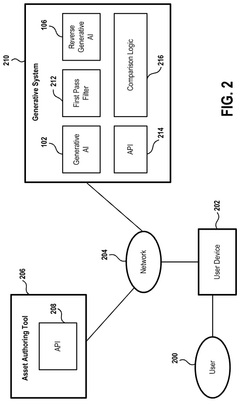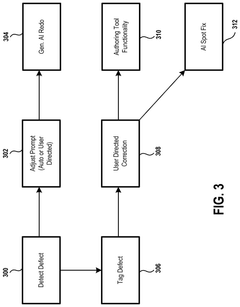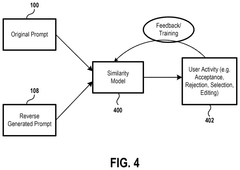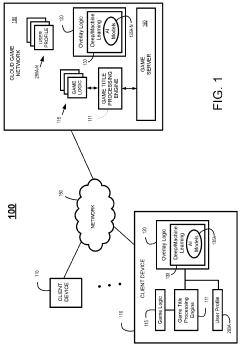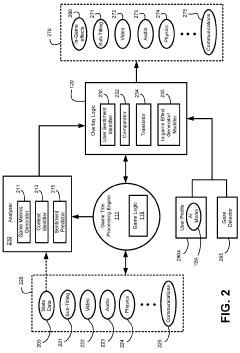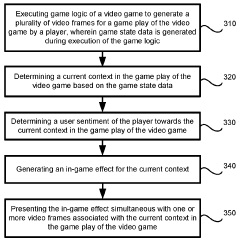Dolby Vision and Its Impact on the Gaming Industry
JUL 30, 20258 MIN READ
Generate Your Research Report Instantly with AI Agent
Patsnap Eureka helps you evaluate technical feasibility & market potential.
Dolby Vision Gaming Evolution
Dolby Vision has undergone a significant evolution in the gaming industry, transforming the visual experience for players worldwide. Initially introduced for cinema and home entertainment, Dolby Vision's journey into gaming began in the mid-2010s as game developers and hardware manufacturers recognized its potential to enhance gaming graphics.
The first major milestone in Dolby Vision gaming came in 2017 when Microsoft announced support for Dolby Vision on the Xbox One S and Xbox One X consoles. This marked the beginning of HDR gaming with Dolby Vision, offering enhanced contrast, brightness, and color accuracy. However, initial implementation was limited to video playback rather than in-game content.
2020 saw a pivotal moment in Dolby Vision gaming evolution with the launch of the Xbox Series X and Series S consoles. These next-generation platforms were designed with native Dolby Vision support, paving the way for true Dolby Vision gaming experiences. In 2021, Microsoft officially rolled out Dolby Vision gaming support for these consoles, allowing games to take full advantage of the technology's capabilities.
The evolution of Dolby Vision in gaming has not been limited to consoles. PC gaming has also embraced the technology, with graphics card manufacturers and monitor producers incorporating Dolby Vision support into their products. This expansion has led to a growing ecosystem of Dolby Vision-compatible gaming hardware and software.
As the technology matured, game developers began to integrate Dolby Vision more deeply into their creative processes. This resulted in games specifically optimized for Dolby Vision, utilizing its advanced color grading and dynamic metadata capabilities to deliver more immersive and visually stunning experiences. Titles like "Halo Infinite" and "Gears 5" showcased the potential of Dolby Vision gaming, setting new standards for visual fidelity.
The most recent developments in Dolby Vision gaming have focused on real-time implementation and optimization. Game engines and development tools have been updated to streamline the integration of Dolby Vision, allowing for more efficient creation of HDR content. Additionally, advancements in AI-driven upscaling and tone mapping have further enhanced the Dolby Vision gaming experience, even for content not natively created with the technology in mind.
Looking ahead, the evolution of Dolby Vision in gaming is expected to continue, with potential integration into virtual and augmented reality experiences, as well as cloud gaming platforms. As display technologies advance and become more affordable, Dolby Vision's impact on the gaming industry is likely to grow, pushing the boundaries of visual quality and immersion in interactive entertainment.
The first major milestone in Dolby Vision gaming came in 2017 when Microsoft announced support for Dolby Vision on the Xbox One S and Xbox One X consoles. This marked the beginning of HDR gaming with Dolby Vision, offering enhanced contrast, brightness, and color accuracy. However, initial implementation was limited to video playback rather than in-game content.
2020 saw a pivotal moment in Dolby Vision gaming evolution with the launch of the Xbox Series X and Series S consoles. These next-generation platforms were designed with native Dolby Vision support, paving the way for true Dolby Vision gaming experiences. In 2021, Microsoft officially rolled out Dolby Vision gaming support for these consoles, allowing games to take full advantage of the technology's capabilities.
The evolution of Dolby Vision in gaming has not been limited to consoles. PC gaming has also embraced the technology, with graphics card manufacturers and monitor producers incorporating Dolby Vision support into their products. This expansion has led to a growing ecosystem of Dolby Vision-compatible gaming hardware and software.
As the technology matured, game developers began to integrate Dolby Vision more deeply into their creative processes. This resulted in games specifically optimized for Dolby Vision, utilizing its advanced color grading and dynamic metadata capabilities to deliver more immersive and visually stunning experiences. Titles like "Halo Infinite" and "Gears 5" showcased the potential of Dolby Vision gaming, setting new standards for visual fidelity.
The most recent developments in Dolby Vision gaming have focused on real-time implementation and optimization. Game engines and development tools have been updated to streamline the integration of Dolby Vision, allowing for more efficient creation of HDR content. Additionally, advancements in AI-driven upscaling and tone mapping have further enhanced the Dolby Vision gaming experience, even for content not natively created with the technology in mind.
Looking ahead, the evolution of Dolby Vision in gaming is expected to continue, with potential integration into virtual and augmented reality experiences, as well as cloud gaming platforms. As display technologies advance and become more affordable, Dolby Vision's impact on the gaming industry is likely to grow, pushing the boundaries of visual quality and immersion in interactive entertainment.
Gaming Market HDR Demand
The gaming industry has witnessed a significant surge in demand for High Dynamic Range (HDR) technology, driven by the increasing consumer appetite for more immersive and visually stunning gaming experiences. As gaming hardware and software capabilities continue to evolve, HDR has emerged as a key differentiator in the market, offering enhanced contrast, brighter highlights, and a wider color gamut that brings game worlds to life with unprecedented realism.
The demand for HDR in gaming is closely tied to the proliferation of 4K and 8K displays, as well as next-generation gaming consoles and high-end gaming PCs. Gamers are increasingly seeking out HDR-compatible hardware and games, recognizing the technology's ability to deliver more vibrant and lifelike visuals. This trend is particularly pronounced in the premium gaming segment, where enthusiasts are willing to invest in cutting-edge technology for the best possible gaming experience.
Market research indicates that the adoption of HDR-capable gaming monitors and TVs has been growing steadily, with a significant portion of new gaming displays now featuring HDR support. This growth is further fueled by the increasing number of game titles that offer HDR modes, allowing players to experience enhanced visual fidelity across a wide range of genres, from fast-paced action games to visually rich open-world adventures.
The demand for HDR in gaming extends beyond the consumer market, with professional esports tournaments and streaming platforms also embracing the technology to enhance the viewing experience for spectators. This has created a ripple effect, driving demand for HDR-capable capture and streaming equipment among content creators and professional gamers.
However, the HDR gaming market is not without its challenges. The lack of standardization in HDR implementation across different platforms and displays has led to some confusion among consumers. Additionally, the premium associated with HDR-capable gaming hardware has limited its accessibility to a broader audience, although prices are gradually becoming more competitive as the technology matures.
Despite these challenges, the overall trajectory of HDR demand in the gaming market remains strongly positive. Industry analysts project continued growth in the adoption of HDR gaming technology, driven by advancements in display technology, increasing support from game developers, and the ongoing push for more immersive gaming experiences. As HDR becomes more prevalent, it is expected to transition from a premium feature to a standard expectation in gaming, further solidifying its importance in the industry.
The demand for HDR in gaming is closely tied to the proliferation of 4K and 8K displays, as well as next-generation gaming consoles and high-end gaming PCs. Gamers are increasingly seeking out HDR-compatible hardware and games, recognizing the technology's ability to deliver more vibrant and lifelike visuals. This trend is particularly pronounced in the premium gaming segment, where enthusiasts are willing to invest in cutting-edge technology for the best possible gaming experience.
Market research indicates that the adoption of HDR-capable gaming monitors and TVs has been growing steadily, with a significant portion of new gaming displays now featuring HDR support. This growth is further fueled by the increasing number of game titles that offer HDR modes, allowing players to experience enhanced visual fidelity across a wide range of genres, from fast-paced action games to visually rich open-world adventures.
The demand for HDR in gaming extends beyond the consumer market, with professional esports tournaments and streaming platforms also embracing the technology to enhance the viewing experience for spectators. This has created a ripple effect, driving demand for HDR-capable capture and streaming equipment among content creators and professional gamers.
However, the HDR gaming market is not without its challenges. The lack of standardization in HDR implementation across different platforms and displays has led to some confusion among consumers. Additionally, the premium associated with HDR-capable gaming hardware has limited its accessibility to a broader audience, although prices are gradually becoming more competitive as the technology matures.
Despite these challenges, the overall trajectory of HDR demand in the gaming market remains strongly positive. Industry analysts project continued growth in the adoption of HDR gaming technology, driven by advancements in display technology, increasing support from game developers, and the ongoing push for more immersive gaming experiences. As HDR becomes more prevalent, it is expected to transition from a premium feature to a standard expectation in gaming, further solidifying its importance in the industry.
Dolby Vision Tech Challenges
Dolby Vision, while revolutionizing the visual experience in gaming, faces several technical challenges that need to be addressed for widespread adoption. One of the primary hurdles is the requirement for specialized hardware capable of processing and displaying Dolby Vision content. This necessitates significant investments from both game developers and hardware manufacturers to ensure compatibility across various platforms and devices.
Another challenge lies in the increased computational demands of Dolby Vision. The technology requires real-time processing of high dynamic range (HDR) content, which can strain system resources, particularly in gaming scenarios where performance is critical. This may lead to trade-offs between visual fidelity and frame rates, potentially impacting gameplay experience.
Content creation for Dolby Vision presents its own set of challenges. Game developers must adapt their workflows to incorporate HDR color grading and dynamic metadata generation, which requires specialized tools and expertise. This can extend development timelines and increase production costs, potentially limiting adoption among smaller studios.
Standardization and cross-platform compatibility remain ongoing concerns. While Dolby Vision has gained traction, competing HDR formats like HDR10+ continue to fragment the market. This lack of a unified standard complicates development processes and may lead to inconsistent experiences across different devices and platforms.
The issue of backward compatibility also poses a significant challenge. Ensuring that Dolby Vision-enhanced games remain playable and visually appealing on non-HDR displays requires careful consideration and additional development effort. This dual-path approach to content creation can further strain resources and complicate quality assurance processes.
Data management and transmission present another hurdle, particularly for streaming and online gaming services. The increased bandwidth requirements for Dolby Vision content may lead to latency issues or reduced image quality in scenarios with limited network capacity. This challenge becomes more pronounced in the context of cloud gaming services, where real-time streaming of high-quality HDR content is essential.
Lastly, the challenge of consumer education and perception cannot be overlooked. While Dolby Vision offers significant visual enhancements, communicating these benefits to the average gamer and justifying potential price premiums for Dolby Vision-enabled hardware and content remains a hurdle for widespread adoption in the gaming industry.
Another challenge lies in the increased computational demands of Dolby Vision. The technology requires real-time processing of high dynamic range (HDR) content, which can strain system resources, particularly in gaming scenarios where performance is critical. This may lead to trade-offs between visual fidelity and frame rates, potentially impacting gameplay experience.
Content creation for Dolby Vision presents its own set of challenges. Game developers must adapt their workflows to incorporate HDR color grading and dynamic metadata generation, which requires specialized tools and expertise. This can extend development timelines and increase production costs, potentially limiting adoption among smaller studios.
Standardization and cross-platform compatibility remain ongoing concerns. While Dolby Vision has gained traction, competing HDR formats like HDR10+ continue to fragment the market. This lack of a unified standard complicates development processes and may lead to inconsistent experiences across different devices and platforms.
The issue of backward compatibility also poses a significant challenge. Ensuring that Dolby Vision-enhanced games remain playable and visually appealing on non-HDR displays requires careful consideration and additional development effort. This dual-path approach to content creation can further strain resources and complicate quality assurance processes.
Data management and transmission present another hurdle, particularly for streaming and online gaming services. The increased bandwidth requirements for Dolby Vision content may lead to latency issues or reduced image quality in scenarios with limited network capacity. This challenge becomes more pronounced in the context of cloud gaming services, where real-time streaming of high-quality HDR content is essential.
Lastly, the challenge of consumer education and perception cannot be overlooked. While Dolby Vision offers significant visual enhancements, communicating these benefits to the average gamer and justifying potential price premiums for Dolby Vision-enabled hardware and content remains a hurdle for widespread adoption in the gaming industry.
Current Dolby Vision Solutions
01 High Dynamic Range (HDR) Technology
Dolby Vision utilizes HDR technology to enhance visual quality by expanding the range of both contrast and color. This results in brighter highlights, deeper blacks, and a wider color gamut, providing a more lifelike and immersive viewing experience.- High Dynamic Range (HDR) Technology: Dolby Vision utilizes HDR technology to enhance visual quality by expanding the range of both contrast and color. This results in brighter highlights, deeper blacks, and a wider color gamut, providing a more lifelike and immersive viewing experience.
- Dynamic Metadata Processing: Dolby Vision employs dynamic metadata processing to optimize the image on a scene-by-scene or even frame-by-frame basis. This allows for more precise control over brightness, contrast, and color, resulting in improved visual quality across various content types and display capabilities.
- Display Calibration and Optimization: Dolby Vision incorporates advanced display calibration and optimization techniques to ensure consistent visual quality across different devices. This includes color mapping, tone mapping, and brightness adjustment to match the specific capabilities of each display.
- Content Creation and Mastering: Dolby Vision provides tools and workflows for content creators to master their content in high quality. This includes color grading, encoding, and delivery processes that preserve the intended visual quality from production to end-user display.
- Compatibility and Backward Support: Dolby Vision is designed to be compatible with various display technologies and can adapt to different device capabilities. It also provides backward compatibility with standard dynamic range (SDR) content, ensuring improved visual quality even for non-HDR sources.
02 Dynamic Metadata Processing
Dolby Vision employs dynamic metadata processing to optimize the image on a scene-by-scene or even frame-by-frame basis. This allows for precise control over brightness, contrast, and color, ensuring that each frame is displayed at its best possible quality.Expand Specific Solutions03 Color Mapping and Gamut Expansion
The technology incorporates advanced color mapping and gamut expansion techniques to reproduce a wider range of colors more accurately. This results in more vibrant and true-to-life images, with smoother color gradients and reduced banding artifacts.Expand Specific Solutions04 Display-Specific Optimization
Dolby Vision adapts its output to the specific capabilities of each display device. This ensures that the content is optimized for the particular characteristics of the screen, such as peak brightness, black levels, and color gamut, maximizing visual quality across different devices.Expand Specific Solutions05 Content Creation and Mastering Tools
The technology provides content creators with specialized tools for mastering and grading content in Dolby Vision. These tools allow for precise control over the visual elements, ensuring that the creator's intent is accurately preserved and reproduced across various display devices.Expand Specific Solutions
Key Dolby Vision Adopters
The gaming industry's adoption of Dolby Vision technology is in its early stages, with the market showing significant growth potential. As the technology matures, it's expected to enhance gaming experiences by offering superior HDR visuals. Key players like Sony Interactive Entertainment, Microsoft, and Nintendo are at the forefront of implementing this technology in their gaming consoles. Companies such as LG Electronics and Koninklijke Philips are also contributing to the ecosystem by producing Dolby Vision-compatible displays. The competitive landscape is evolving, with game developers and hardware manufacturers collaborating to leverage Dolby Vision's capabilities, potentially reshaping the gaming market's visual standards and consumer expectations.
Sony Interactive Entertainment LLC
Technical Solution: Sony has embraced Dolby Vision technology in its PlayStation 5 console, offering enhanced visual experiences for compatible games. The PS5 supports Dolby Vision for streaming apps and Blu-ray playback, with plans to extend this support to gaming[3]. Sony's implementation focuses on leveraging Dolby Vision to enhance the HDR capabilities of its games, providing more vibrant colors, improved contrast, and better highlight details. The company has also developed its own HDR technology, HDR10, which works in tandem with Dolby Vision to ensure a wide range of compatibility across different display types[4]. Sony's approach includes optimizing game engines to take full advantage of Dolby Vision's capabilities, potentially leading to more visually stunning and immersive gaming experiences on their platform.
Strengths: Strong hardware integration and potential for exclusive Dolby Vision-enhanced titles. Weaknesses: Limited game library supporting Dolby Vision at present and potential licensing costs.
Microsoft Technology Licensing LLC
Technical Solution: Microsoft has been at the forefront of implementing Dolby Vision in the gaming industry, particularly with its Xbox Series X and S consoles. These consoles were among the first to support Dolby Vision for gaming, offering enhanced visual fidelity across a wide range of titles[5]. Microsoft's implementation allows for automatic HDR calibration, ensuring optimal picture settings for each game. The company has also worked closely with game developers to integrate Dolby Vision support into both new and existing titles through backwards compatibility[6]. Microsoft's approach includes a feature called "Dolby Vision for Games," which can enhance even non-Dolby Vision content, providing a more consistent HDR experience across the entire game library. This technology also works in conjunction with other features like Auto HDR and VRR to provide a comprehensive visual enhancement package for gamers.
Strengths: Early adoption and wide implementation of Dolby Vision in gaming, strong developer support. Weaknesses: Requires Dolby Vision-compatible displays for full benefit, potential increased hardware costs.
Core Dolby Vision Patents
Reverse auto generation of generative ai engine prompts based on output results for self-validation
PatentPendingUS20250117645A1
Innovation
- Implementing a method that involves reverse automatic generation of generative AI engine prompts based on output results for self-validation, using a reverse generative AI to generate a prompt from the output and comparing it to the original prompt to determine similarity and validate the generated output.
User sentiment detection to identify user impairment during game play providing for automatic generation or modification of in-game effects
PatentWO2024026206A1
Innovation
- Implementing overlay logic in game engines to detect user sentiment and generate in-game effects that enhance the gaming experience for impaired players by modifying or adding subtitles, animations, and other visual cues to convey the intended sentiment, using artificial intelligence to predict player preferences and personalize in-game effects.
Gaming Hardware Requirements
Dolby Vision's implementation in the gaming industry necessitates specific hardware requirements to fully leverage its capabilities. Modern gaming consoles and high-end PCs are at the forefront of supporting this technology, with manufacturers adapting their hardware to meet the demands of Dolby Vision's advanced HDR processing.
For gaming consoles, the latest generation devices such as the Xbox Series X and PlayStation 5 have been designed with Dolby Vision compatibility in mind. These consoles feature powerful GPUs capable of rendering complex HDR scenes in real-time, along with HDMI 2.1 ports that support the high bandwidth required for Dolby Vision's enhanced color and brightness data.
In the PC gaming realm, graphics cards play a crucial role in Dolby Vision support. NVIDIA's RTX series and AMD's Radeon RX series GPUs are equipped with dedicated hardware for HDR processing, enabling them to handle Dolby Vision's demanding requirements. These GPUs must be paired with compatible displays that can accurately reproduce the wide color gamut and high dynamic range of Dolby Vision content.
Display technology is another critical component in the Dolby Vision gaming ecosystem. Monitors and TVs must meet specific criteria to be certified for Dolby Vision, including high peak brightness levels, typically exceeding 1000 nits, and the ability to display a wide color gamut covering at least 90% of the DCI-P3 color space. OLED and high-end LED-LCD panels with local dimming capabilities are commonly used to achieve these specifications.
The implementation of Dolby Vision in gaming also places demands on system memory and storage. Fast RAM and SSDs are essential for managing the increased data throughput required for real-time HDR processing and the larger file sizes associated with Dolby Vision-enhanced game assets.
As game developers increasingly adopt Dolby Vision, there is a growing need for specialized development tools and hardware. This includes calibrated reference monitors for accurate color grading and HDR content creation, as well as powerful workstations capable of rendering and processing Dolby Vision content during the game development phase.
The integration of Dolby Vision into gaming hardware represents a significant step forward in visual fidelity, but it also presents challenges for hardware manufacturers and consumers alike. Balancing the cost of implementing these advanced features with market demand and consumer affordability remains an ongoing consideration in the evolution of gaming hardware.
For gaming consoles, the latest generation devices such as the Xbox Series X and PlayStation 5 have been designed with Dolby Vision compatibility in mind. These consoles feature powerful GPUs capable of rendering complex HDR scenes in real-time, along with HDMI 2.1 ports that support the high bandwidth required for Dolby Vision's enhanced color and brightness data.
In the PC gaming realm, graphics cards play a crucial role in Dolby Vision support. NVIDIA's RTX series and AMD's Radeon RX series GPUs are equipped with dedicated hardware for HDR processing, enabling them to handle Dolby Vision's demanding requirements. These GPUs must be paired with compatible displays that can accurately reproduce the wide color gamut and high dynamic range of Dolby Vision content.
Display technology is another critical component in the Dolby Vision gaming ecosystem. Monitors and TVs must meet specific criteria to be certified for Dolby Vision, including high peak brightness levels, typically exceeding 1000 nits, and the ability to display a wide color gamut covering at least 90% of the DCI-P3 color space. OLED and high-end LED-LCD panels with local dimming capabilities are commonly used to achieve these specifications.
The implementation of Dolby Vision in gaming also places demands on system memory and storage. Fast RAM and SSDs are essential for managing the increased data throughput required for real-time HDR processing and the larger file sizes associated with Dolby Vision-enhanced game assets.
As game developers increasingly adopt Dolby Vision, there is a growing need for specialized development tools and hardware. This includes calibrated reference monitors for accurate color grading and HDR content creation, as well as powerful workstations capable of rendering and processing Dolby Vision content during the game development phase.
The integration of Dolby Vision into gaming hardware represents a significant step forward in visual fidelity, but it also presents challenges for hardware manufacturers and consumers alike. Balancing the cost of implementing these advanced features with market demand and consumer affordability remains an ongoing consideration in the evolution of gaming hardware.
Dolby Vision Licensing Model
Dolby Vision's licensing model plays a crucial role in its adoption and impact on the gaming industry. The model is structured to encourage widespread implementation while ensuring Dolby Laboratories maintains control over the technology's quality and distribution.
At the core of the licensing model is a tiered system that accommodates different types of manufacturers and content creators. For hardware manufacturers, such as gaming console producers and TV makers, Dolby offers licenses that allow them to integrate Dolby Vision technology into their devices. These licenses typically involve an upfront fee and ongoing royalties based on the number of units sold.
Content creators, including game developers and publishers, have a separate licensing structure. They are required to obtain licenses to produce and distribute Dolby Vision-enabled content. This ensures that the content meets Dolby's standards and can be properly displayed on compatible devices.
Dolby has implemented a certification program as part of its licensing model. This program requires manufacturers to submit their products for testing and approval before they can use the Dolby Vision branding. This helps maintain consistency in the user experience across different devices and platforms.
The licensing model also includes provisions for software development kits (SDKs) and application programming interfaces (APIs). These tools are provided to licensees to facilitate the integration of Dolby Vision into their products and content creation workflows. This approach helps streamline the adoption process and ensures compatibility across the ecosystem.
Dolby's licensing strategy for the gaming industry has been designed to be flexible and scalable. It accommodates both large AAA game studios and smaller independent developers, with licensing terms that can be adjusted based on the scale of production and distribution.
One notable aspect of the licensing model is its emphasis on interoperability. Dolby encourages licensees to work together to ensure that Dolby Vision-enabled games can be played seamlessly across different platforms and devices. This approach has helped foster a more unified gaming experience for consumers.
The licensing model also includes provisions for ongoing support and updates. Licensees receive access to technical documentation, training resources, and regular updates to the Dolby Vision technology. This ensures that the implementation of Dolby Vision in games and gaming hardware remains current and optimized.
As the gaming industry continues to evolve, Dolby's licensing model has shown adaptability. The company has demonstrated willingness to adjust its terms and conditions to accommodate new technologies and market trends, such as cloud gaming and virtual reality, which are becoming increasingly relevant to the gaming ecosystem.
At the core of the licensing model is a tiered system that accommodates different types of manufacturers and content creators. For hardware manufacturers, such as gaming console producers and TV makers, Dolby offers licenses that allow them to integrate Dolby Vision technology into their devices. These licenses typically involve an upfront fee and ongoing royalties based on the number of units sold.
Content creators, including game developers and publishers, have a separate licensing structure. They are required to obtain licenses to produce and distribute Dolby Vision-enabled content. This ensures that the content meets Dolby's standards and can be properly displayed on compatible devices.
Dolby has implemented a certification program as part of its licensing model. This program requires manufacturers to submit their products for testing and approval before they can use the Dolby Vision branding. This helps maintain consistency in the user experience across different devices and platforms.
The licensing model also includes provisions for software development kits (SDKs) and application programming interfaces (APIs). These tools are provided to licensees to facilitate the integration of Dolby Vision into their products and content creation workflows. This approach helps streamline the adoption process and ensures compatibility across the ecosystem.
Dolby's licensing strategy for the gaming industry has been designed to be flexible and scalable. It accommodates both large AAA game studios and smaller independent developers, with licensing terms that can be adjusted based on the scale of production and distribution.
One notable aspect of the licensing model is its emphasis on interoperability. Dolby encourages licensees to work together to ensure that Dolby Vision-enabled games can be played seamlessly across different platforms and devices. This approach has helped foster a more unified gaming experience for consumers.
The licensing model also includes provisions for ongoing support and updates. Licensees receive access to technical documentation, training resources, and regular updates to the Dolby Vision technology. This ensures that the implementation of Dolby Vision in games and gaming hardware remains current and optimized.
As the gaming industry continues to evolve, Dolby's licensing model has shown adaptability. The company has demonstrated willingness to adjust its terms and conditions to accommodate new technologies and market trends, such as cloud gaming and virtual reality, which are becoming increasingly relevant to the gaming ecosystem.
Unlock deeper insights with Patsnap Eureka Quick Research — get a full tech report to explore trends and direct your research. Try now!
Generate Your Research Report Instantly with AI Agent
Supercharge your innovation with Patsnap Eureka AI Agent Platform!
